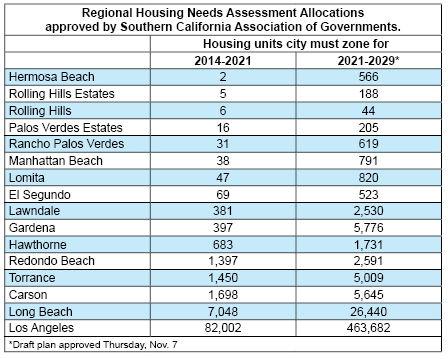
Southern California will need to make room for another 1.3 million more housing units over the next 10 years, with the coastal cities of Los Angeles and Orange counties the preferred destination rather than inland communities, according to a draft plan approved this week by a regional governing body.
The Southern California Association of Governments, a 70-member association made up of officials from cities across six counties (not including San Diego), OK’d the plan — known as a Regional Housing Needs Assessment Allocation Plan — which will now go to the California Department of Housing and Community Development for review; it will then be finalized, according to Jeff Liu, SCAG spokesman.
The RHNA allocations determine how much housing cities must allow under their zoning laws but does not require those units be actually built.
The way the allocation for each city is determined comes down to a complicated formula that has changed slightly from the last time it was created, Liu said. The previous allocation numbers set in 2014 were also developed during a recession, which affected the outcome.
Under the draft plan, Torrance, for instance, would have to zone for 5,009 additional housing units — across income levels — by 2029. Five years ago, the city’s allocation was 1,450 units.
Torrance Mayor Patrick Furey said implementing such a requirement will be difficult, if not impossible.
“Every time they come up with a number, it’s very difficult for the local agencies to comply with those numbers,” Furey said. “The city has been a built-out city since the mid ’70s.”
In Long Beach, SCAG approved a housing allocation of 26,440 additional units by 2029, up from its last allocation of 7,048 units by 2021, a nearly four-fold increase. Gardena went from 397 to 5,776; Hawthorne went from 683 to 1,731; and Lawndale went from 381 to 2,530.
In Redondo Beach, where officials have long-argued that the regional association’s methodology was flawed, SCAG allocated 2,591 units, up from 1,397 five years ago.
“The problem with RHNA is it’s based on population, so it considers the population increase and voila,” said Councilwoman Laura Emdee. “Just pushing housing into places that already have a high density and high population is just not fair and not equitable at all.”
Sentiments aired by South Bay officials echoed those throughout small coastal cities, where policies that increase density are often met with stiff resistance from residents, many of whom view any increase in residents as an increase in traffic.
Recent bills signed into law by Gov. Gavin Newsom will take more local control away from city governments, largely stripping their ability to limit growth. Any restrictions local planners can put on accessory dwelling units, for instance, have nearly been completely removed in a series of bills Newsom has recently signed.
“There’s a feeling when we are going through this process that some of the cities are built out,” Liu said. “The main message from yesterday’s meeting is, yes, in the inland empire there is open land. But where are the jobs? They are in L.A. and Orange (counties).
“So, to make people drive from Riverside to L.A. and Orange (counties) will only create more traffic and auto pollution,” Liu added. “It’s just going to make people’s lives more miserable. So why can’t we provide more housing along transit and where the jobs are located?”
Los Angeles bears among the greatest burden in the latest numbers from SCAG, with the association determining that the city must zone for an additional 463,682 new homes and apartments — up from 82,002 in 2014.
In San Pedro, which is part of the city of Los Angeles, the density factor is already hitting home. For a while now, neighborhood councils have grappled with the prospects of a number of proposed mixed-use projects — some being built, others in various stages of the planning process — that will bring hundreds of new residents into the immediate downtown shopping district.
Parking and traffic are among the top concerns in the area, which is surrounded by water on three sides and has very few major thoroughfares to take people in and out of town. The community doesn’t have a large employment base however, So many new residents could end up commuting to jobs elsewhere.
But supporters of the draft plan — including Los Angeles City Councilman Joe Buscaino — look at waterfront redevelopment and projects such as AltaSea, a marine research campus under development, as possible drivers for what could be a new economic and job base in the coming years.
In Manhattan Beach, its housing allocation went from 38 by 2021 to 791 by 2029. Mayor Nancy Hersman said the figure was “staggering” and strained to imagine where it might even be possible to put those units.
“I don’t know anyone who can look at Manhattan Beach and imagine 791 housing units,” Hersman said. “I can tell you residents are not happy with it.
“We do understand the housing issue in California and certainly locally,” she said. “We’re not unsympathetic to that, but at the same time, we don’t exactly have a lot of free land.”